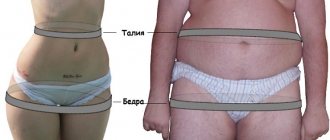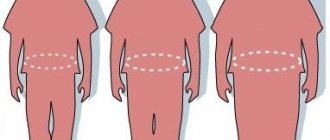Why do you need to know your BMI?
Data from the World Health Organization indicate that obesity is currently one of the leading diseases in the world. Doctors successfully fight various kinds of pathologies, infections, and diseases. But the fight against excess weight has not yet shown good results. This is due to an incorrect lifestyle, an abundance of fast food, fatty foods. The consequences of obesity and excess weight are terrifying - type 2 diabetes, a tendency to heart attacks, disruption of the functioning of internal organs.
Body mass index may indicate problems occurring in the body:
- an increased value indicates the risk of serious diseases associated with excess weight: hypertension, diabetes, varicose veins, problems of the cardiovascular, digestive systems, internal organs;
- a reduced value is a signal of exhaustion, possible deficiencies of vitamins, minerals, and nutrients. A weakened body is less resistant to external influences. There is a decrease in local immunity and protective reactions. A lack of fat mass and a low BMI may indicate type 1 diabetes, osteoporosis, digestive disorders, mental problems, and eating disorders.
Norm
Strictly categorizing people as underweight or obese based on body mass index alone is, in fact, not rational enough. If a person fits into the above-mentioned category (pregnant women, athletes), then using BMI is generally inappropriate.
BMI will still not be as accurate as bioimpedance analysis taking into account age and gender. This is a way of assessing physique in which an electrical impulse is passed through the body. Different tissues of the body resist current in different ways, and this way you can find out the ratio of these tissues in the body. However, BMI parameters have a correlation with real pathologies.
So, according to statistics:
- people under 20 years of age and over 25 years of age and having a high BMI were associated with greater all-cause mortality. Mostly from chronic diseases;
- the risk increased with distance from the range of 20–25, which is the norm.
BMI is interpreted differently for children and adolescents, although it is calculated using the same formula as adult BMI.
The BMI of children and adolescents should be:
- specific to the child’s age (categories “child”, “youth”, “teenager”);
- gender-specific (different for girls and boys, respectively);
- take into account the ratio of fat depending on age and muscle depending on the gender of the child.
In the body of adolescents, the endocrine system changes intensively and the reproductive function develops. The level of subcutaneous body fat differs between girls and boys. Also, with age, the value of the body mass index corresponding to normal increases.
Depending on gender
Gender differences in the regulation of BMI have been proven by modern research. Scientists say that even the risk factors for obesity differ significantly between the sexes. Thus, women are more prone to emotional overeating than men. For men, most of the differences between the high and low health risk groups were explained by levels of nutritional competence and conscientious restriction of food intake.
BMI based on age and gender is shown in the table below:
| Normal BMI depending on age in men | |
| Age | Body mass index |
| 19–24 | 21,4 |
| 25–34 | 21,6 |
| 35–44 | 22,9 |
| 45–54 | 25,8 |
| After 55 | 26,6 |
The female body differs from the male body primarily due to hormonal instability. Thus, the level of hormones, as is known, in the female body is constantly changing, while in the male body it is relatively stable.
Changes in body composition and, consequently, body mass index, in most women are associated with menstrual cycles. Therefore, the BMI norm for women is slightly higher. Fat helps accumulate the appropriate hormones to maintain reproductive function: it should make up 20–30% of the total weight.
BMI (body mass index) taking into account age and gender in the table.
| Normal BMI depending on age in men | |
| Age | Body mass index |
| 19–24 | 19,5 |
| 25–34 | 23,2 |
| 35–44 | 23,4 |
| 45–54 | 25,2 |
| After 55 | 27,3 |
How to calculate body mass index for women
BMI is usually calculated using Adolphe Quetelet’s formula. It was developed in the middle of the last century and takes into account only a person’s height and weight. In this case, age and other individual characteristics, such as waist or hip circumference, are not taken into account. To correctly interpret the obtained value, weight loss specialists resort to additional research: it is necessary to identify the true reasons for gaining extra pounds in order to draw up a plan for getting rid of them.
Once your BMI is determined, if it is higher than normal for your height, weight and age, it is recommended that you undergo a comprehensive examination at a weight loss clinic. It is important to determine the percentage of fat and muscle tissue. Such a serious and thorough approach to the problem may be life-saving. Why? Because fat deposits are usually concentrated in certain areas: on the stomach, thighs, and around the internal organs. Certain combinations, sizes and proportions of these deposits, which are detected during examination at a weight loss clinic, may indicate dangerous diseases. And the simple generally accepted BMI formula, of course, does not take into account all the details of the location of extra pounds.
Your ideal weight
A woman's weight is considered ideal if:
- does not cause discomfort;
- does not limit a woman when performing everyday activities;
- does not cause health problems;
- does not carry potential risks: the likelihood of developing type 2 diabetes, high blood pressure, high cholesterol, heart disease.
There are various ways to determine your ideal weight. The most common are the following:
- By body mass index. If it is normal and there are no concomitant diseases, there is no need to worry.
- Subtract 110 from your height in centimeters.
- Along the fat fold on the abdomen. The norm for women is 2-4 cm.
- Use an online calculator.
The best way to determine the value of your body mass index is to undergo a comprehensive examination using special equipment. It is available in weight loss clinics. Experts will determine the ratio of fat and muscle mass, ideal weight, indicators necessary to determine the state of health and create a diet.
Formula for calculating BMI according to Kreff
The technique is an improved and expanded method for calculating the real body mass index, which was developed in 1871 by the French surgeon and anthropologist Paul Brocq. It is considered most suitable for people with a height of 155-185 cm. In this range, the error is minimal. The technique takes into account age and anthropometric parameters.
Calculation of BMI using the Kreff formula is based on the typical anatomical relationships of different parts of the body and skeletal structures. The technique is poorly suited for calculating BMI values in people with a non-standard figure.
Kreff's formula is as follows: body weight = (exact height in cm - 100) + (age/10)*0.9*K. A special coefficient has been introduced into it, equal to the volume of the wrist and denoted by the letter K.
When the girth of this part of the body is less than 15 cm, K = 0.9. If the wrist volume is 15-17 cm, 1 is substituted into the formula. If the volume exceeds 17 cm, the corresponding value is K = 1.1. This coefficient takes into account your body type.
Body Mass Index Formula
There is a generally accepted formula by A. Quetelet that allows you to calculate BMI. It has the form: I=m/h², where m is body weight (kg), h is height (m).
Calculating your body mass index will not take much time. The main thing is to correctly interpret the resulting value. The World Health Organization proposes the following classification based on the data obtained:
| Index value | What does the indicator say? |
| Less than 16 | There is a pronounced lack of body weight, exhaustion of the body |
| From 16 to 19 | Body weight is insufficient, there is a deficiency |
| From 19 to 25 | Weight is within normal limits |
| From 25 to 30 | There is excess weight, the stage of pre-obesity is observed |
| From 30 to 35 | Obesity type 1 |
| From 35 to 40 | Obesity type 2 |
| Over 40 | Obesity type 3 |
It is better to calculate your body mass index based on your age. The norm for age intervals for women is different, shown in the following table:
| Age | Body mass index for women by age |
| 19-25 | 19,6 |
| 25-35 | 23,3 |
| 35-45 | 23,5 |
| 45-55 | 25,3 |
| Over 55 | 27,4 |
If a woman’s body mass index shows significant excess weight or even some stage of obesity, a weight loss specialist prescribes additional tests and refers her to a psychotherapist for consultation. After all, it is important to establish the true reasons for weight gain or loss. Perhaps then it will be necessary to teach the patient to independently deal with problems leading to deviations and illnesses, and to begin to live in a completely new way. It’s not for nothing that professionals say that improving your psycho-emotional background and changing your eating habits is the key to a new, healthy body. And these are not just beautiful words, but everyday reality.
What is BMI, definition
The following is currently known about body mass index:
- BMI is an index used in medicine.
- BMI is a quantitative parameter that is calculated using formulas or based on comparison with pictures.
- BMI was originally invented to help diagnose obesity.
- BMI is a relative value. When making a diagnosis, you cannot rely solely on it.
- BMI is used in fitness, dietetics and bodybuilding.
- Other ways to “measure” a figure include: bioimpedance analysis, pinching a skin fold, comparison with diagrams and drawings.
Experts calculate body mass index using a formula. In order to determine BMI, it is necessary to know the patient’s current body weight in kilograms, as well as his height in centimeters. Classic calculations are expressed in units equal to kg/m2. These, in turn, are obtained from body weight divided by height in meters. To calculate body weight and height, pounds, meters, inches are also used, and not just kilograms and centimeters.
There are 2 main formulas for determining BMI, one of which determines the body mass index in the metric system, and the second in the imperial system. Body mass index can be calculated both using the above formulas and using visual representations: charts, tables, drawings, with which the specialist compares the patient to determine his physique.
BMI is not an accurate criterion for assessing human health, so you need to use not only mathematical methods for determining body mass index, but also visual ones. There is a scientifically proven correlation between a lower BMI and fewer cardiovascular diseases, cancer and diabetes. But there are also significant differences in the physique of two people who have the same BMI but lead different lifestyles.
Body mass index has earned its recognition and demand among people because it is a convenient and simple way that is suitable for most people to determine their health and take measures to improve it. It will not be valid for all people, but is excellent for initial diagnosis. The modern term "body mass index" was coined in an article published in the July 1972 issue of the Journal of Chronic Disease.
In this article, the author - Ancel Case - argued that what he called BMI was "...if not entirely satisfactory, then at least as good as any other relative weight index as an indicator of relative obesity."
BMI, taking into account age and gender, was initially used to a greater extent to diagnose obesity. And in most cases, a diagnostician who would determine the level of health of his patient using BMI and would identify an index that is too high (obesity of 1 or 2 degrees), then he would receive valid information. But the same would not work for a patient who is a professional bodybuilder.
People who are involved in building muscle mass or professional sports should be especially attentive to the value of their BMI. High numbers do not mean that they are obese, because muscle is thicker than fat tissue.
Body mass index has been used by doctors for more than a century. This formula has become the world standard for the initial diagnosis of patients with suspected obesity or anorexia. However, along with BMI, doctors use special tables, graphs and pictures to accurately determine body composition and predict treatment if necessary.
BMI is different for men and women. The fact is that female and male bodies differ significantly in functioning. For example, it has been proven that the female body is more prone to storing adipose tissue than the male body. And, conversely, the male body, due to high levels of the hormone testosterone, is prone to building muscle mass.
Body mass index was popularized due to the spread of the obesity epidemic in the 1980s. This problem is still relevant today, and nutritionists, therapists, endocrinologists and other specialists use the BMI formula for the primary diagnosis of their patients. Excess or underweight can be partly explained by excess adipose tissue. But other factors, such as muscle mass, also significantly influence BMI.
Thus, body mass index values are affected by the following:
- The amount of water in the body. For example, swelling or dehydration can increase your BMI.
- Body type. As a rule, although not by much (about 2 kg), the bones differ between people with asthenic and hypersthenic physiques.
- Development of skeletal muscles. People who regularly go to the gym and intentionally increase their body weight through muscle may have an even higher BMI than people who are actually obese or pre-obese.
- Measurement time. It is recommended that all measurements to determine your body mass index be taken in the morning before breakfast.
Online calculator for calculating BMI
An online BMI calculator is the fastest, easiest way to find the true value. There are different sites: some take into account only height and weight, others also age. The second one is more popular, since it allows you to get the most accurate value. For older people, a slight deviation from the optimal BMI value is considered normal.
The BMI calculator works simply. All that is required from a person is:
- indicate gender. Women, for example, tend to have a lower BMI;
- enter height and weight;
- Enter the full number of years or indicate the date of birth.
The BMI calculator will calculate the value in a few seconds and indicate which of the listed intervals it belongs to: deficiency, normal, pre-obese or one of the stages of obesity.
BMI calculator
Enter information about the person for whom you want to find out the body mass index. To do this, fill out the fields below and click the “Calculate” button.
Age must be between 18 and 100!
Height must be a number greater than zero!
The weight must be a number greater than zero!
BMI value accuracy
The indicator cannot be considered absolutely reliable and universal . In each specific case, an individual approach is required with adjustments and amendments, the need for which is determined by personal physiological factors.
The convention of BMI is best illustrated by the fact that the 2012 Olympic weightlifting champion Behdad Salimi had this figure of 44.5 kg/m2. This value corresponds to obesity.
The classic formula does not take into account:
- floor;
- age;
- percentage ratio of fat fibers to muscle fibers;
- three-dimensional structure of the human body and other influencing factors.
Calculating BMI (the formula becomes more accurate when individual adjustments are made) only makes sense to obtain approximate information about a person’s health status.
Oxford University professor Nick Trefenthen has expressed doubts about the accuracy of the body mass index, since it does not take into account the actual features of human anatomy. The relationship between weight and height changes nonlinearly. As a result, the classic formula considers short people to be slimmer and denser than tall people. This is not always true.
Severe underweight
If the BMI value for women is less than 16, there is only one conclusion - there is a pronounced underweight. This may indicate a number of serious diseases and severe depletion of the body. Only a specialist can make an accurate diagnosis.
There are several main reasons why underweight may occur:
- insufficient food consumption: inability to eat due to work, stress, difficult life situation, conscious refusal to eat;
- diseases of the gastrointestinal tract that interfere with the absorption of vitamins, minerals, and nutrients;
- unhealthy lifestyle: unbalanced, unhealthy diet, bad habits, lack of physical activity;
- hereditary predisposition.
It is important to start treatment on time and contact competent specialists. Usually, a comprehensive methodology is required: changing eating habits, nutrition in combination with the work of a psychologist.
Underweight
Typically, a BMI value below 19 indicates underweight. This is no less a serious problem than obesity, ignoring which can lead to anemia, anorexia - diseases dangerous to the body, accompanied by loss of strength, fainting, migraines, disruption of the cardiovascular and digestive systems, weakening of the immune system and the body's defense reactions.
Insufficient body weight in women may indicate the following diseases:
- neuropsychic exhaustion;
- hormonal disorders;
- overwork;
- infectious and viral diseases;
- problems in the gastrointestinal tract;
- eating disorders.
The problem of underweight should not be ignored, as the disease can take a more serious form that is life-threatening. When gaining weight, an integrated approach is important, a special technique that includes proper rest, proper nutrition, moderate physical activity, and work with a psychologist.
Norm and deviations
On the official WHO website there is a special table that shows both the BMI norm and deviations. Using it, we look for which category we fell into with our I = 31.25.
We did not fall into the normal body mass index, and the table no longer shows just extra pounds, but class I obesity (an overview of obesity classifications can be found at the link).
So calculating BMI and comparing the data obtained with the norm is not at all difficult. The problem is that the formula is already outdated, and the WHO table does not reflect all factors. This means that the results may not be entirely correct.
Normal body weight
Normally, BMI should be from 18.5 to 25. If the resulting value is in this range, most likely there are no problems with excess weight. However, consultation with a specialist is necessary, since Quetelet’s formula:
- Does not take into account the location of fat deposits. Athletes who have a high percentage of muscle will score high, close to being pre-obese or obese. Although this is not true.
- Not suitable for pensioners. Excess weight is normal for people over 60. Their norm may be in the range of 22-26.
Weight loss specialists with many years of experience are able to accurately diagnose and identify existing dangers and predispositions. Even slim people are recommended to periodically undergo a comprehensive examination at a weight loss clinic:
- Do a clinical blood test and ESR to determine the condition of the body, check the level of glucose and glycated hemoglobin, which are responsible for the balance of insulin.
- Make a lipid profile that reflects the metabolism of fats in the body. It allows you to track cholesterol levels, exclude obesity and heart disease.
- Find out the ratio of fat and muscle mass, localization of deposits. Visceral fat, concentrated around vital organs, can cause the development of many diseases. A person can be very slim and not even think about such a problem.
Excess body weight
Experts distinguish two forms of excess body weight:
- Fat deposits are caused by external influences: lifestyle, eating habits, lack of motor and physical activity, stress. About 70% of people suffer from “obesity from laziness.”
- Fat accumulation occurs as a result of certain diseases, disorders of lipid and metabolic metabolism, and is associated with problems in the functioning of the endocrine system.
Weight gain is caused by an imbalance caused by excess food consumption, insufficient physical activity, and problems with the psycho-emotional state. It turns out that the body receives more energy than it expends.
Consequences of low and high BMI
A weight index over 30 is considered an etiological factor for colorectal oncological hyperplasia. Excess weight contributes to hearing impairment in older patients, especially women during menopause. Obesity (BMI 40 or more) is the cause of obstructive sleep apnea syndrome.
Excess weight, according to WHO, increases the risk by 25 times:
- hypertensive crises;
- stroke;
- diabetes mellitus;
- osteoarthritis - a destructive pathology of joints associated with the inability of joints to fulfill their functional purpose.
In fertile women, the likelihood of developing malignant tumors of the mammary glands, uterus and ovaries increases significantly. Excess weight leads to vascular thrombosis and causes varicose veins.
Low body weight inhibits immunity and reproductive function.
A BMI of less than 18.5 is associated with a degenerative state of musculoskeletal structures, which contributes to increased fragility of skeletal elements. It is necessary to calculate your weight to avoid anemia - a deficiency of hemoglobin in the blood. Current formulas can only give a general idea of the state of health.
Obesity
Obesity refers to excess fat deposits located in the subcutaneous layer, organs, and tissues. This is the most dangerous disease for the body, causing self-doubt, problems in intimate life, psycho-emotional discomfort, and disruption of internal organs. The listed problems require solutions, a competent, comprehensive approach. The technique should cover all aspects of weight loss:
- Psychology. Responsible for motivation, forming habits, getting rid of complexes, changing attitudes towards food.
- Proper nutrition, which involves changing eating habits and eating behavior. The patient will not be required to adhere to a strict diet or count calories.
- Rehabilitation. The loss of extra pounds is accompanied by sagging skin, loss of its elasticity and smoothness. How to enter the new form and accept it? Rehabilitation therapy and cosmetology will help.
- Socialization. Losing weight largely depends on the support of family, friends and acquaintances. What if they are indifferent or even against? Competent psychological assistance will help.
This technique has been repeatedly confirmed by the world scientific community and is effectively used in practice.
There are four main types of obesity:
- Excess weight accounts for 29% of body weight. The BMI of such people is in the range of 30-35.
- Excess by 30-40%, index - 35-40.
- Exceeding more than 40%. Body obesity index over 40.
- Weight is twice or more times the ideal weight. This type is considered the most dangerous.
Example of calculating body mass index
The formula from Adolphe Quetelet is not ideal, but is widely used in medical practice. It is easy to calculate your body mass index. Let's consider an example: it is necessary to determine the BMI value for a girl with a height of 168 centimeters and a weight of 65 kg. The algorithm is as follows:
- square the height in meters: 1.68×1.68=2.8;
- divide the mass in kilograms by the resulting value: 65/2.8=23;
- Body mass index is 23. It ranges from 19 to 25. Weight is normal.
Monitoring your BMI readings will help you maintain your weight and health: according to the World Health Organization, excess weight can lead to type 2 diabetes, problems with the cardiovascular system, and hypertension. Do not neglect your own well-being and health. Timely diagnosis in a weight loss clinic under the guidance of competent specialists is the best solution.
Features of determining indicators
BMI, taking into account age and gender, is calculated using the following basic parameters:
- Height in cm, inches . Height in centimeters at home is measured using a measuring tape. You need to take off your shoes, stand near a flat vertical surface and outline the top point of your head - the crown - on the wall. Then measure the distance from the floor to the line using tape.
- Weight in kg, lbs . The weight in kilograms can be obtained using a bathroom scale. If you don’t have these at home, you can use a weighing service from a therapist at the nearest clinic or medical center.
- Waist circumference in cm, inches (OT). To measure your waist correctly, you need to stand up straight and place the tape measure around your waist, just above your hips. Measure your waist immediately after exhaling.
- Hip circumference in cm, inches (OB). To measure it, you also need a centimeter tape. The widest part of the thigh is measured.
- Wrist circumference in cm, inches (OZ). Wrist circumference is used not only to determine BMI, but also to determine body composition. As you know, there are three body types: asthenic, normosthenic and hypersthenic.
| Methods for calculating body mass index | |
| Metric measurements | The product of weight in kilograms and meters squared. |
| Complete equation (height in cm). | |
| Imperial dimensions | The square of height, calculated in inches. |
| The product of current weight then divided by height. | |
To manually calculate your metric body mass index:
- The first method is the product of weight in kg per m of height. For example, if your weight is 65 kilograms and your height in meters squared is 2.05, then you need to divide 65 by 2.05. The body mass index, accordingly, will be equal to 31.7.
- The second way is an equation that looks like this: kg/m2. In this equation, “kg” is your current weight in kilograms. “M” is your current height in meters. These numbers are weight in kg, divided by height in cm, again divided by height in cm and after all this, therefore, the resulting figure is multiplied by 10,000.
Another, and simplest option is to simply change your height in centimeters to meters. Or immediately measure your height with a centimeter tape, not a meter tape. This will avoid unnecessary confusion in number systems. Imperial Measurements are a set of units first defined in the British Weights and Measures Act of 1824. The system is used in the UK, USA, Myanmar, partly in Canada, Liberia.
This system, although not in demand in Russia, is also used to calculate BMI in the following ways:
- The first way is to square your height, measured in inches. To square height, multiply it by itself. For example, if you are 65 inches tall, you would multiply 65 by 65. The answer is 4225.
- The second way is to measure your actual weight in pounds and multiply it with your height measured in inches. The second action will be the product of the resulting number by the square of the growth. For example, if the weight in pounds is 190, then you need to divide this number by 4900. The answer will be 0.03673. The last operation is to multiply this answer by 703. For example, 0.03877. Next, the resulting number must be multiplied by 703. The result is 27.25, if rounded. Thus, the approximate body mass index is 27.25.











